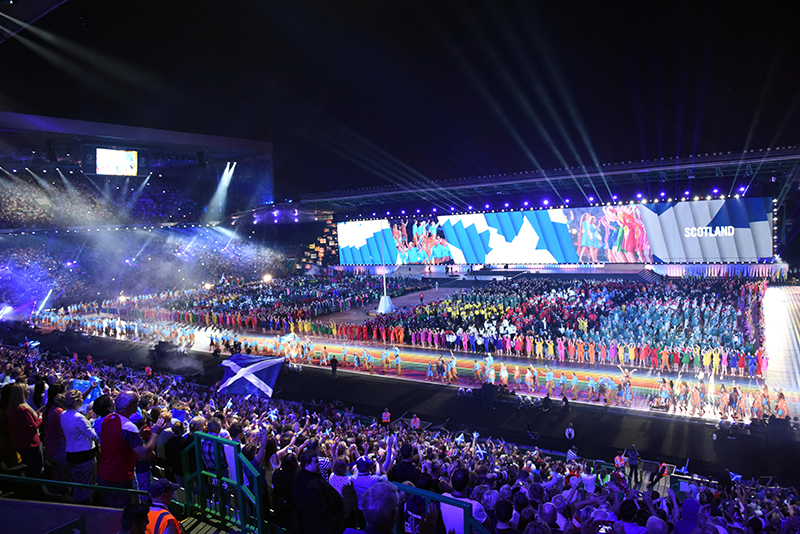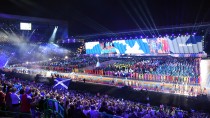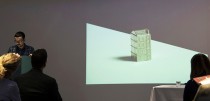Over the last three months, ISO have been working with global brand experience agency, Jack Morton to deliver the graphics and visual effects for the XX Commonwealth Games 2014 Opening Ceremony. With the largest screen ever to be seen in Europe at a staggering 100 metres long, 11 metres high, and weighing in at 38 tonnes, the team worked to deliver twenty different sequences using various design techniques such as time-lapse and particle animation. With a highly-successful Opening Ceremony behind them, Creative Directors Mark Breslin, Damien Smith and Clyde Lawson took some time to talk to Central Station about their design process.
With the largest screen in Europe, what sort of challenges did you face?
DS: Filling it for over two hours! It’s an enormous image area that is ultra high-resolution. It’s 5000 pixels wide and it’s a really unusual format. It’s like designing for 5 cinema screens in width.
Can you tell us about how the show was built?
MB: We designed twenty sequences with a mixture of purely linear sections and others composited within the playback system. The time lapse photography was quite an interesting challenge. It had to be created from a single frame meaning that the aspect ratio had to be altered for the thinner screen.
Some of it was supplied as a kit of parts so we would create animations and then break them down into their component parts and send them over as individual elements. It’s interesting because you don’t realise how some of it is going to work in situ. We created content with a lot of flexibility so we could re-jig it in situ.
CL: Ultimately, the kit of parts were then broken into hundreds of numbered tiles which were sent to the screens. We only saw them on screen two weeks before it went live.
DS: You can never visualise how it’s going to look on that scale. We see it with some of our video installation work. What looks great on screen, when seen in a room or immersive environment, changes your perspective on the media completely. You often have to slow things down because people get motion sickness. It’s taking that to an exponential degree in this case!
How did you go about translating concepts like “People Make Glasgow” and “Freedom Come All Ye” into tangible designs?
MB: They can go through the traditional design process so for “Freedom Come All Ye,” you look at the lyrics as your starting point and look and explore some of the themes or words, like ‘wind’, ‘blossom’ being a carrier for the message. We developed a number of different approaches which in this case were amalgamated into the final sequence. While you’re developing the treatments you have to retain an overview of how it’ll work in the context of the overall performance.
DS: You might go through three design concepts before you nail something. It’s an interesting part of the design process, to see which ideas survive. With some concepts, it really is survival of the fittest.
CL: From there you do test animations to show them the concept and get it nailed down. Part of the experience is a good client. That’s an important part of the jigsaw. Working with the producers at Jack Morton was a pleasant surprise.
DS: They’ve been here in Glasgow for over a year. They’re an international group who travel from major opening to major opening. At their core, there was a British creative team. It’s been great to watch all the strands pull together on such a large scale.
Opening Ceremonies used to just be ‘Here’s the opening of the games, here’s the dry speeches, give the athletes a parade.’ Now post-London host cities seem to have to encapsulate how a nation sees itself and how it projects itself in the future. That’s a lot to ask of any entertainment.
With so many different design elements, how did you decide on using specific techniques like particle animation and time lapse?
MB: It’s part of the theme of welcoming the Queen as Head of the Commonwealth and showing Scotland as a location, but it’s also more of an ambient scene as opposed to a high entry part of the show. The show is very thematic with a lot of variety. There was a different approach to each chapter and the graphics had to reflect that. For example, we used particle based animation (code-generated graphics) in Freedom Come All Ye.
DS: There was a script for each sequence but it was left open ended as to how we would visualise that. In some instances, animation was better. In others, it was photography and film.
CL: Over the whole two hours, we featured different techniques and styles to keep the show fresh and interesting. It’s also very different from what we normally do. This was a live show that we were building rather than a film as part of an experience. The tone of each piece is important and how it lifts and contrasts with other parts.
DS: Unlike a lot of film work we do this project involved working in parallel with a number of different departments: choreography, live performance, pyrotechnics, lighting, TV directors, live OB. You have to work in a complementary way with all of them.
What other techniques did you explore in creating the visual graphics for the show?
DS: We used traditional 2D motion graphics and collaborated with quite a few people with a team of about fifteen. In house, it was a big team effort from our talented designers Chris Bain, Blair Harrower, Brendan Bennett, Tom Pollock, Ross Douglas, producer Jamie Gillespie and ourselves. We also had associates like Will Anderson working on the Nelson Mandela sequence which was traditional hand drawn animation. Mark Huskisson was responsible for the time-lapse photography. And a regular collaborator of ours, Danny Carr worked on motion graphics. We used 3-D graphics to explode Wellington’s cone in the opening sequence and there was also a 3-D space station. The Queen’s baton was also 3D animation and we had John Butler working on that.
MB: Chris Bowman from XL media was housed in the studio a week before the gear went on-site, building and sequencing the show on the playback system. He worked closely with us on the technical issues and show build as well as creating flexible frameworks for queuing graphics and integrating areas of live feeds.
DS: Something of that scale is so environmental. The designers are living and breathing that but until you actually see it in a stadium surrounded by people with the sound and the music and the lights, it’s a different experience.
What were you most pleased with about the opening ceremony?
DS: As a TV experience, I liked the athletes parade. In many ways, it’s the driest section. It’s really only about information but it was dynamic and it seemed to whip along the crowd. The athletes came in and the place was washed with colour and movement. So in many ways, it’s the biggest and most functional section and is usually the most utilitarian moment of the opening; I think the designers really added some beauty and art to that.
London and Glasgow both have huge visual arts cultures. What keeps you in Glasgow?
CL: You don’t need to be in London to do this type of work though there seems to be the perception that you have to be. It’s great to do a project like this up here. We do work on this scale but never in Scotland, so it’s the first time we’ve done something like this here. It’s a great opportunity for us.
DS: We had to pitch against London companies for this job. It’s expected that you’re going to pitch against London agencies, but where you’re based doesn’t affect the work you do that drastically. In this case, it was to our advantage in that we had daily physical contact with the client. Generally we’re based here because as Clyde said, you don’t have to be in London. There’s a creative melting pot in Glasgow. In London people live and work in quite specific silos creatively, whereas in Glasgow there is much more of an overlap.
MB: It’s also a nightmare trying to get Tunnock’s teacakes in London.
What’s ISO’s next big project?
DS: We just finished 18 media installations for the new WWI galleries for the Imperial War Museum 4 days before the Games Opening so we are taking a short break! Our next big media installation projects are in Sweden and the Middle East.
Interview by Madeleine Schmoll.
//////
Want to read more Q&As with creatives? Find them here.
















Comments